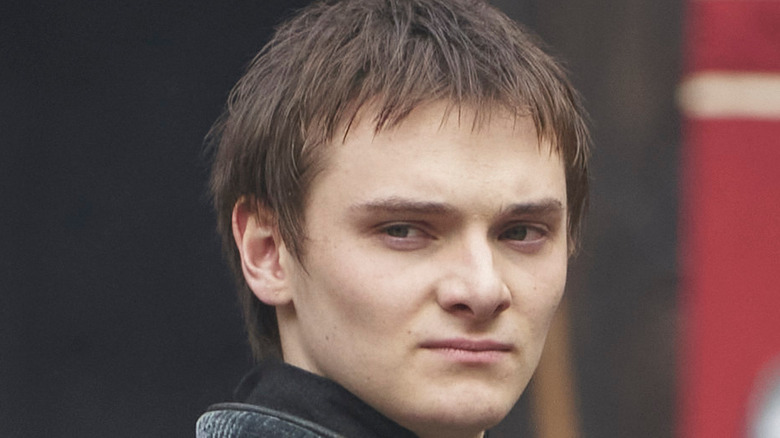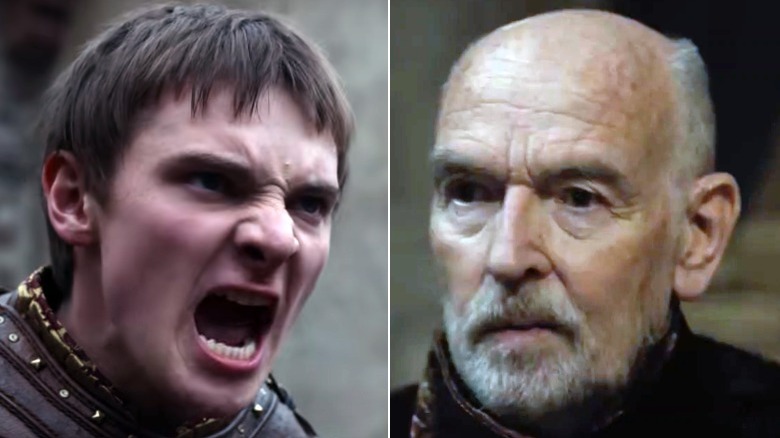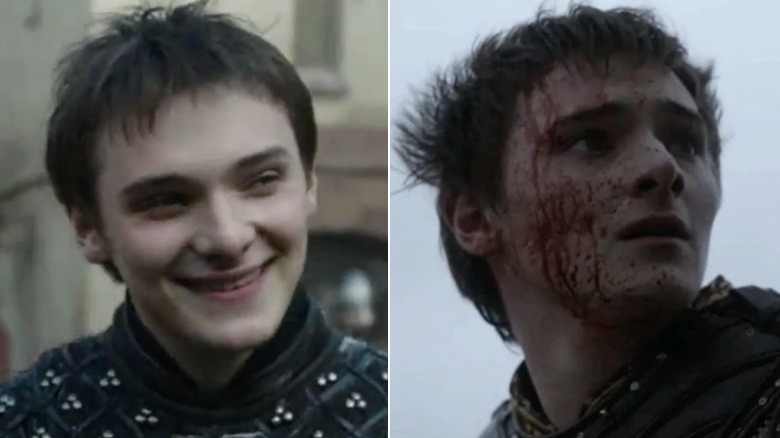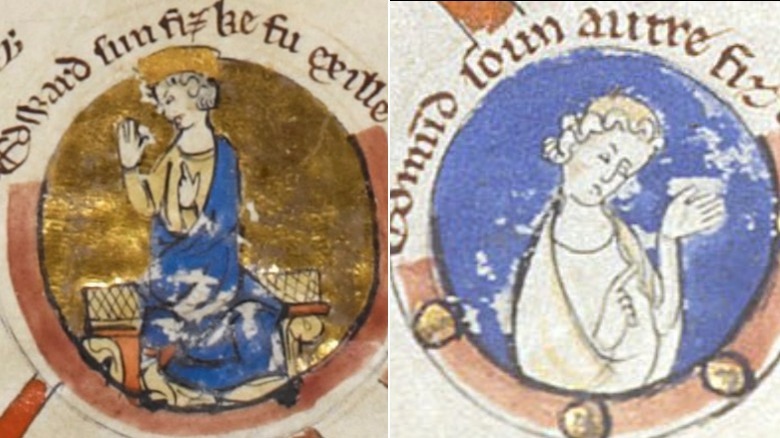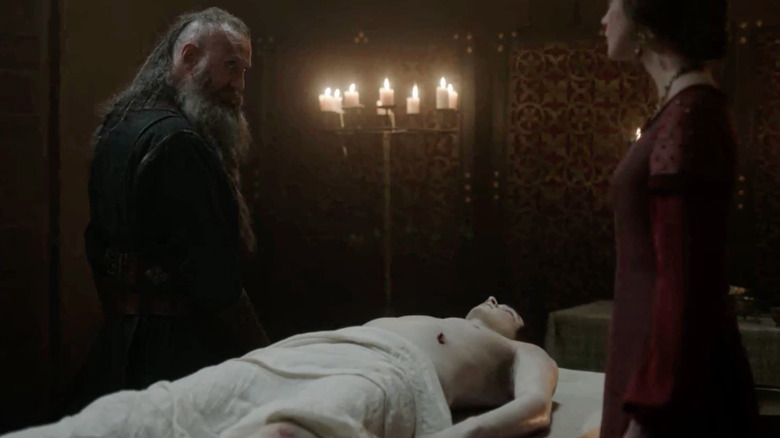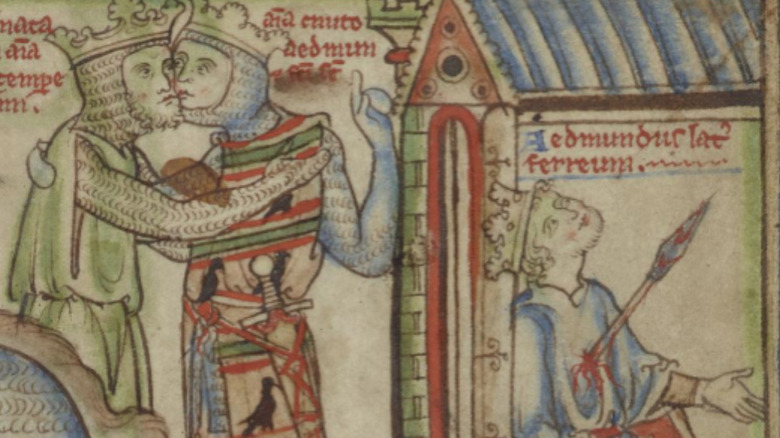What Vikings: Valhalla Gets Wrong About King Edmund
Contains spoilers for "Vikings: Valhalla" Season 1
Like most pieces of historical fiction, "Vikings: Valhalla" makes ample use of the artistic license that Hollywood is so famous for. In fact, although most of the characters are based on real-life historical figures, there are multiple instances of characters interacting with people their genuine counterparts never even met in the real world.
For example, though the two grow quite close throughout the first season, there is no absolutely no indication whatsoever that Freydis Eriksdotter (Frida Gustavsson) ever met Jarl Haakon (Caroline Henderson) (via YouTube). Of course, considering the series also gender and race swapped the latter character, it's reasonable to assume that the writers are more focused on entertaining viewers than they are on accurately informing them of history.
This is also true of the show's portrayal of King Edmund II (aka Edmund Ironside) (Louis Davison). As is portrayed in the series, Edmund ascended to the English throne upon the death of his father, Æthelred II, in 1016 and led his country for around seven months before meeting an untimely death. However, this is pretty much where the definitive commonalties between the real world's Edmund and the small screen's Edmund begin and end.
Edmund Ironside led a revolt against his father
When we first meet Edmund in "Vikings: Valhalla" Season 1, Episode 2 ("Viking"), he is shown praying at his father's bedside as his father's life comes to an end. In Season 1, Episode 3 ("The Marshes"), he assumes the same position in front of his father's body just prior to burial. Though both of these scenes are certainly touching displays of love and grief, neither probably ever happened in real life. In fact, history indicates that the relationship between this father and son might not have even been particularly close.
In 1015, Æthelred II ordered that Ealdgyth, the widow of a recently murdered enemy, be imprisoned in a monastery. However, Edmund decided that the final year of his father's life was also the sublime opportunity to defy him and lead a revolt. Instead of leaving the widow in the monastery, Edmund married her, seized her former husband's lands, and granted himself the title of Earl of the East Midlands in a direct challenge to his father's will (via Freelance History Writer).
Later that same year, Edmund returned to London in the face of a growing Viking invasion led by King Canute the Great (Bradley Freegard) (more on that later). Though it technically remains possible that Edmund could have had a change of heart in the final months of a his father's life, such pious behavior seems unlikely after all of that completely unmentioned bad blood.
Edmund is remembered for his bravery, not his childishness
Though the series portrays Edmund as somewhat akin to Joffrey Lannister Baratheon à la "Game of Thrones," stories from the real Edmund's life suggest this comparison isn't even the slightest bit legitimate.
In Season 1, Episode 3 ("The Marshes"), Edmund insists on showing off his sword-fighting skills. Though he handily defeats various members of his own army, he obviously struggles to respond as well to Earl Godwin (David Oakes). Edmund is quickly shown to be both overconfident and inexperienced in combat and diplomacy, ultimately leading to a series of grand blunders at the Battle of Assandun in Season 1, Episode 4 ("The Bridge").
In real life, however, Edmund was so renowned for his bravery in various battles against the Vikings that he was granted the cognomen "Ironside." In addition to leading his men in attempting to thwart Canute's advances, sources indicate that Edmund might have also fought against an earlier Viking invasion led by Canute's father, Sweyn Forkbeard. Though it is true that Edmund's forces lost the Battle of Assandun in October of 1016, he is also said to have led them in a whole four other battles preceding it (via Medievalists).
Edmund probably wasn't that much younger than Canute the Great
Though the real-life Edmund was certainly young at the time of his ascendency by modern standards, genuine chronicles of history indicate that "Vikings: Valhalla" is forgetting a few things for narrative convenience.
Sweyn Forkbeard (Soren Pilmark) calls Edmund a "boy king" in Season 1, Episode 7 ("Choices"), but records actually indicate that Edmund was born around the same time as Sweyn's son, King Canute the Great (Bradley Freegard). Of course, records of such detail are spotty for so long ago, but the best estimates of researchers place Edmund's birth year somewhere around 990 (via BritRoyals). Similarly, King Canute's birth year is typically placed anywhere between 985 and 995, meaning it's entirely possible that Canute was actually the younger of the two (via English History)!
By the end of 1015, only a few months before he took the throne, Edmund was already married to Ealdgyth and the father to one child, Edmund Ætheling. A second child, Edward, is estimated to have been born at some point in 1016, although it is unknown if this occurred before or after Edmund's death in November of the same year. After Edmund died, Canute became King of all of England, including Wessex, and moved to banish Edmund's surviving family members, including his only two descendants (via History... The Interesting Bits).
Edmund died two years after Sweyn Forkbeard
Historical fiction series like "Vikings: Valhalla" often like to play fast and loose with the timeline of real-world events. For example, although Canute's invasion of England appears to be almost entirely motivated by Æthelred's role in the Saint Brice's Day Massacre, these historical events are not quite as directly causal as one might think from watching the series. In fact, while the Saint Brice's Day Massacre is confidently pegged at occurring in November 1002, most of the dramatic events at the heart of the series, including Canute's victory, did not occur until 1016, a whole 14 years later (via History Hit).
Another notable delineation from the genuine timeline is the Season 1, Episode 7 ("Choices") appearance of Sweyn Forkbeard. In this episode, Earl Godwin quietly murders Edmund and is forced to explain the king's death to Canute's father, Sweyn Forkbeard. However, a simple look at the history books proves this would be quite impossible. Sweyn actually died in February of 1014, nearly a whole three years before Edmund met his end in November of 1016 (via Historic UK). Notably, this isn't the only thing that writers saw fit to change about Edmund's departure from this world.
Edmund's death was probably very different
In addition to playing with the timeline a bit, "Vikings: Valhalla" uses a hefty amount of creativity in regards to the manner of Edmund's death. The series portrays Edmund as quietly murdered by Earl Godwin, but there doesn't appear to be any real-world evidence that suggests this is true.
The exact location and cause of Edmund's passing has sadly been lost to time. Though it is clear that the king died in November 1016 at somewhere around 25 or 26 years of age, all other aspects of his untimely death consist of mere speculation and legend. Some scholars believe that Edmund actually died as a result of wounds suffered in battle (via A Clerk of Oxford). This would obviously make some sense as it was only a few weeks after Edmund's aforementioned loss at the Battle of Assandun. However, it is decidedly less inventive than the other offered explanations.
Another version of events claims that an assailant either stabbed Edmund with a knife or shot him with a crossbow while the king was resting on a toilet (à la Tywin Lannister for you "Game of Thrones" fans). Other details of this story rather fantastically place the alleged murderer in the bottom of Edmund's outhouse (yes, that bottom), but this claim has never been corroborated by reliable sources (via History of Yesterday).
